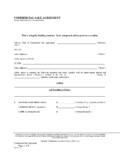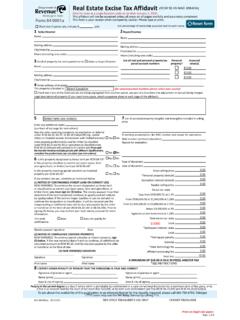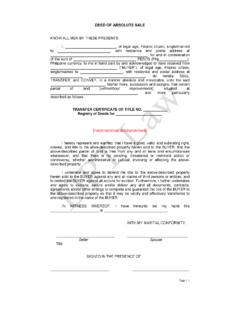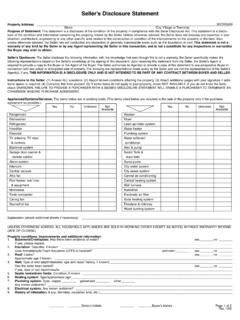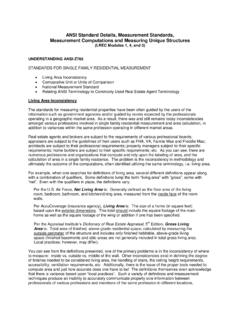Transcription of Guidance on the Lead-Based Paint Disclosure Rule
1 August 21, Department of Housingand Urban DevelopmentGuidance on the Lead-BasedPaint Disclosure RulePrepared by theOffice of Lead-Based Paint Abatement and Poisoning Department of Housing and Urban DevelopmentWashington, 20460and the Office of Pollution Prevention and Environmental Protection AgencyWashington, 20410 Note:This document is also available via the HUD Lead Office World Wide Web home page of Date of - and Representatives and of vs. vs. Whole of Disclosure for on Disclosure Paint Guidance FOR THE REAL ESTATE COMMUNITY ON THEREQUIREMENTS FOR Disclosure OF INFORMATIONCONCERNING Lead-Based Paint IN HOUSINGINTRODUCTIONOn March 6, 1996, the Environmental Protection Agency (EPA) and the Department ofHousing and Urban Development (HUD) published a final rule, "Lead; Requirements forDisclosure of Known Lead-Based Paint and/or Lead-Based Paint Hazards in Housing," (61 FR9064-9088).
2 This final rule requires persons selling or leasing most residential housing builtbefore 1978 to provide purchasers and renters with a federally approved lead hazard informationpamphlet and to disclose known Lead-Based Paint and/or Lead-Based Paint hazards. The specificrequirements of the final rule are discussed in detail in the March 1996 notice. Other documentsused in the development of this rule are included in a public docket available for inspection atEPA. The requirements of the final rule are applicable as follows: (1) For owners of more thanfour residential dwellings, the requirements are applicable beginning on September 6, 1996, and(2) For owners of one to four residential dwellings, the requirements are applicable beginning onDecember 6, 1996.
3 Subsequent to the publication of the final rule, EPA and HUD have received questionsfrom the real estate community about implementation of the rule. EPA and HUD have developedthis "Interpretive Guidance " document to supplement the information presented in the final rule. This Guidance will be expanded and updated as necessary. To assist the general public, EPA and HUD made the document, "EPA and HUD RealEstate Notification and Disclosure Rule: Questions and Answers" available when they publishedthe final rule. This document, EPA-747-F-96-001, March, 1996, and others may be obtainedfrom the National Lead Information Clearinghouse (NLIC) at (800) 424-LEAD, or TDD(800)526-5456 for the hearing impaired. Requests may also be sent by fax to (202) 659-1192 or byInternet E-mail to DATE OF RULEG eneral1.
4 Q:What part of a sale or rental transaction must occur on or after the effective date for therule to apply? A:The rule generally applies if the buyer or renter becomes obligated under a contract2to purchase or lease target housing on or after the effective date of the rule(September 6, 1996 or December 6, 1996, depending on the number of dwellingunits owned).2. Q:What is the effective date for sale or rental transactions involving cooperatives ("co-ops")and condominiums ("condos")? A:EPA and HUD recognize that both the individual unit "owner" and the corporationor homeowner association may have an ownership interest in co-ops and condos (seeanswer to question # 10). However, EPA and HUD believe that when a co-op orcondo unit is sold or rented, the focus of the transaction is the single unit.
5 Therefore, as a matter of policy, EPA and HUD have determined that the effectivedate will be based on the number of dwellings "owned" (meaning in some cases, thenumber of co-op shares or condo units owned) by the individual seller or lessor asopposed to the number of units that comprise the co-op or condo. Where co-ops orcondos are being directly sold or leased by the corporation (as in a renovatedbuilding being newly offered), however, the applicable date would depend on thenumber of units owned by the corporation. Sales Transactions3. Q:Is the rule effective for sales agreements entered into before the effective date, whereclosing occurs after the effective date? A:The rule will not apply to target housing transactions where the sales agreement issigned and all contingencies have been removed before the effective date, even ifclosing occurs after the effective Agreements4.
6 Q:What is the effective date of the rule for the following situation? A real estate or propertymanagement firm represents 40 property owners who own four units each. Each of the 40property owners' effective date would clearly be December 6, 1996 (four or less units) ifthey were managing their own properties. However, because the real estate or propertymanagement firm is managing 160 rental units (40x4) on behalf of the owners, would theybe subject to the September 6, 1996 effective date ? A:The effective dates in the rule refer specifically to the number of residentialdwellings owned. Although the property manager is managing more than fourproperties, each individual owner only owns four properties. Therefore, theeffective date for property managers of properties with four units each per ownerwould be December 6, Q:In some cases, as in the New York City Rent Stabilization Law, owners must offer3renewal leases to rent-stabilized tenants 120 to 150 days before their current leases expire.
7 This 120-150 day period may occur prior to the September 6 effective date, but therenewal lease could start after the September 6 effective date. Must an owner include thedisclosure forms with the 120-150 day offer of renewal, even though this occurs beforethe effective date? A:The rule applies to obligations made on or after the effective date. Thus, the dateupon which a renewal lease is offered is not particularly relevant under the rule. Itis the date that the offer is accepted, if such acceptance constitutes an obligation torent, that determines whether or not the rules apply. For written leases, this wouldmean that regardless of when the renewal leases are offered to the tenant, the rulewould apply to all renewal leases signed by the tenant (and any contingencies havebeen removed) on or after the effective date.
8 The rule does not apply to cases wherethe renewal leases have been signed by tenants (and contingencies removed) prior tothe effective date, even if the lease does not begin until after the effective date. APPLICABILITYH ousing - Pre-19786. Q:Target housing is housing built before 1978. Does this include or exclude housing thatwas started in 1977, but not completed until 1978? A:EPA and HUD consider "housing constructed before 1978" to mean housing forwhich a construction permit was obtained (or if no permit was obtained, housing inwhich construction was started) before January 1, Dwellings7. Q:Would "0-bedroom dwellings" include college fraternity and sorority houses, dormitorysuites, married student housing, and university-owned apartments?
9 A:The rule excludes "0-bedroom dwellings." The definition of "0-bedroom dwelling"includes "rentals of individual rooms in residential dwellings," and EPA and HUDbelieve that rentals of rooms in fraternity and sorority houses generally fit thatmodel and would be exempt. The definition of "0-bedroom dwelling" alsospecifically includes dormitory housing, which would encompass typical dormitorysuites. However, married student housing and university-owned apartmentstypically are not "0-bedroom dwellings" and would be covered by the rule if theymeet the other criteria for target housing set out in the Q:What is the definition of housing for persons with disabilities? A:Housing for persons with disabilities means communities or similar types of housingspecifically designed for one or more persons with a physical or mental impairmentwhich substantially limits one or more major life activities at the time of initialoccupancy (HUD, Fair Housing Accessibility Guidelines, 56 FR 9472, 3/6/91).
10 However, the exclusion for persons with disabilities from the definition of "targethousing" does not cover housing in which any child who is less than 6 years of ageresides or is expected to Q:Are daycare centers included in the scope of the final rule? A:Section 1018 of Title X focusses specifically on residential housing. As such, the ruledoes not apply to commercial facilities such as daycare centers and nurseries, exceptwhere such facilities are part of a residential and :Who is responsible for Disclosure in the case of co-ops or condos? What about commonareas? A:EPA and HUD recognize that co-ops and condos can be structured in a variety ofways. For example, in the case of co-ops, a corporation may be established and thiscorporation would own all the units and common areas comprising the co-op;individual unit "owners" would own shares in the corporation and might also ownoccupancy rights or lease a unit from the corporation.










